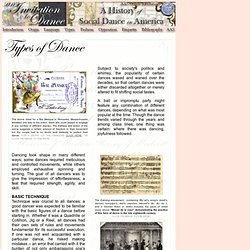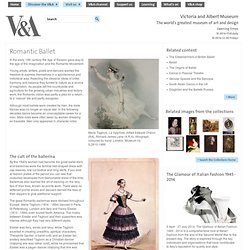

Great Performances: Free To Dance - Dance Timeline (1619-1889) Broadway: The American Musical. As theater styles and personalities from around the world and the country come to New York, the theater district is born — and so is the American musical.

Long Acre Square renamed Times Square, after THE NEW YORK TIMES builds its new office tower on 42nd Street and Broadway. George M. Cohan makes his solo Broadway debut as star and composer of "Little Johnny Jones"; songs include "Give My Regards to Broadway. " Dance%20Spec%20Ed%20Supplement. File:Romeo and juliet brown.jpg. Lincoln's Missing Bodyguard. Home - USADance.org. File:Romeo and juliet brown.jpg. Department of Dance. French Opera House, New Orleans. The Inn on Bourbon, on the corner of Toulouse and Bourbon Streets, rests on the site of the Old French Opera House, for 60 years, the cultural center of New Orleans Creole society, and the first opera house in the United States.

Erected in 1859 at a cost of 118,000 dollars, it was opened to the public on December 1, 1859. The opera house was one of the most famous masterpieces designed by noted architect James Gallier, architect of Gallier Hall and many other classic 18th century buildings. The great elliptical auditorium was beautifully arranged with a color scheme of red and white, and seated 1,800 persons in four tiers of seats. It was Greek revival in design, and its colonnaded front measured 166 feet on Bourbon Street and 187 feet on Toulouse Street.
Its 80-foot high loft towered above all of the buildings of the French Quarter. French Opera Programs"La Juive" Halevy, 11/10/1888, "Les Huguenots" "Les Huguenots" Meyerbeer, 3/2/1889. National Museum of Dance & Hall of Fame. Dancing - News - Times Topics. Dance Magazine – If it's happening in the world of dance, it's happening in Dance Magazine. A Dance blog made out of all Dance blogs. Login to your Website - Webs. Types of Dance: A History of Social Dance in America. The cotillion was usually performed in a square of four couples.

Cotillion steps were similar to those seen in country dances but usually employed more intricate combinations. Common to all cotillions were verses known as "changes," that would come before a chorus that was particular to the dance being performed. Changes signaled movements such as circles and various types of turns, and occurred up to nine or ten times during a cotillion.
Frenchopera. Ballet Legends: Famous Ballerina and Ballet Innovator Marie Camargo « Ballet Academy « Famous Ballerina. Ballet Innovator Marie Camargo Legendary French ballerina Marie Anne de Cupis de Camargo was born in Brussels in 1710. Marie’s family could hardly make ends meet. Her father of Spanish ancestry, who was earning peanuts as a dance instructor and violinist, trained Marie for stage since her childhood.
Her talents got noticed by the first dancer of Paris Opéra Françoise Prévost . She took Marie under her wing and gave her lessons. Scripps College - Oregon Shakespeare Festival 2013. This summer, plan to join Scripps alumnae and friends for our 19th annual trip to the world-famous Oregon Shakespeare Festival.

This is a unique opportunity to experience the nation’s best in repertory theatre in a picturesque small town. Joining the trip this year as our faculty expert will be Patricia Ruth ’73. Patty did her graduate work at the University of Virginia and Stanford, where her dissertation was on Shakespearean comedy. File:Romeo and juliet brown.jpg. Our American Cousin. Our American Cousin is a play in three acts by Tom Taylor.

The play is a farcical comedy whose plot is based on the introduction of an awkward, boorish American to his aristocratic English relatives. It premiered at Laura Keene’s Theatre in New York City on October 15, 1858. The play’s most famous performance came seven years later, however, at Ford’s Theatre in Washington, D.C. on April 14, 1865. Halfway through Act III, Scene 2, the character Asa Trenchard (the titular cousin), played that night by Harry Hawk, utters one of the play’s funniest lines — however little sense it makes out of context: “Don’t know the manners of good society, eh?
During the raucous laughter that followed this line, John Wilkes Booth, an actor who received his mail at Ford’s Theater but who was not in the cast of Our American Cousin, assassinated Abraham Lincoln. Before its history was changed by Lincoln’s assassination, the play had already made a cultural impact. Great Performances: Free To Dance - Dance Timeline (1619-1889) Romantic Ballet. Marie Taglioni, La Sylphide, Alfred Edward Chalon (RA), Richard James Lane (A.R.A). lithograph, coloured by hand, London.

Museum no. S.2610-1986 In the early 19th century the Age of Reason gave way to the age of the imagination and the Romantic Movement. Young artists, writers, poets and dancers wanted the freedom to express themselves in a spontaneous and individual way. Rejecting the classical ideas of order, harmony and balance they turned to nature as a source of inspiration. Although most ballets were created by men, the male dancer was no longer an equal star. Broadway: The American Musical. Ballet Legends: Famous Ballerina and Ballet Innovator Marie Camargo « Ballet Academy « Famous Ballerina.